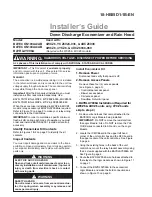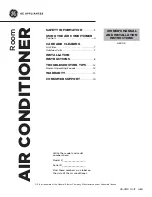
CyberAiR DX Floor Mounted IOM Manual
If newly installed supply and return piping is used,
it is recommended that the piping system be
cleaned
prior to connecting it to the unit.
If solvents/cleaning
solutions are used, ensure they are completely
flushed from the piping before connecting it.
Failure to do so could result in equipment problems.
CAUTION
When installing and filling water, water/glycol
and hot water reheat loops, all air must be
bled from the piping system.
NOTE
Vertical runs are based on a total rise of 30
equivalent feet. For longer sizes, individual
calculations must be made. Sizes assume the use of
single risers; double risers may be necessary.
Consult ASHRAE standards and refer to the
Copeland applications data guide for more detailed
information regarding refrigerant line traps and line
sizing.
2.7.2
Water/Glycol and Hot Water Piping
Field piping may not necessarily be the same size as
the pipe connection on the unit. Piping should be
sized to match the system pressure drop and flow
capacity and may require reducing fittings to match
the connection size on the air conditioner. An air vent
and several Schrader valves are installed in the unit
piping. Refer
to the piping diagram supplied with your unit. Provide
manual shut-off valves in both the supply and return
lines for servicing the unit and for emergency
isolation.
NOTE
A 20 mesh (opening size = 865 microns)
stainless steel Y-strainer with blowdown is
recommended to be installed in the supply
line. The strainer screen should be cleaned
periodically
CAUTION
Fluid coils and associated piping circuits are
pressurized (up to 100 psi)
and sealed
when the unit leaves the factory. Before
installing the interconnecting piping, release
the pressure via an available stem valve or
Schrader valve prior to uncapping the pipes.
NOTE
Water/glycol cooled systems with low
entering fluid temperatures should have
insulated piping to prevent condensation from
forming on the pipes if ambient dew point
temperatures are higher than the fluid
temperatures.
The recommended ethylene glycol solution
ratio is 40% glycol to 60% water. (STULZ
recommends
Dowtherm SR1 manufactured by Dow Chemical
Co.) Use only ethylene glycol with inhibitors for
corrosion protection.
WARNING
Glycol is hazardous. Consult the
manufacturer’s MSDS for detailed safety
information.
2.7.3
Condensate Drain
2.7.3.1 Gravity Drain
A drain line is provided to drain the condensate pan.
If an optional humidifier is used, the drain line from
the humidifier is typically connected to the
condensate drain line. The end of the drain line is
clamped inside the cabinet. The installer must
connect a customer supplied drain hose to the end
of the drain line to remove water from the cabinet.
See the installation drawing provided with your unit
for the size and location of the condensate drain
line.
NOTE
In most cases the humidifier drains (hot)
water into the condensate drain during
normal operation. As an option, a separate
drain line may be provided for the humidifier.
The drain line must be located so it will not be
exposed to freezing temperatures. The diameter of
the drain line should be the full size of the
connection.
2-11
Recommended Discharge Line Sizes for R-
410A Refrigerant
CFS Model No.
/Total BTU
Capacity
Equivalent Length Ft.*
50’
or less
100’
or less
150’
or less
021 / 72,000
5/8
5/8
5/8
028 / 96,000
7/8
7/8
7/8
035 / 120,000
7/8
7/8
7/8
053 / 180,000
1-1/8
1-1/8
1-1/8
070 / 240,000
1-1/8
1-1/8
1-1/8
088 / 300,000
1-1/8
1-1/8
1-1/8
105 / 360,000
1 3/8
1 3/8
1 3/8
















































